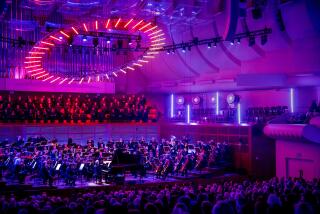Percussion-Related Concert a Fusion of Sound, Setting
A pleasurably odd new music garden party descended on the Schindler house in West Hollywood on Saturday, in an event all about unconventional percussion-related sound and thinking. The sounds were made by celebrated percussionist William Winant. The thinking came from composer James Tenney, and the venue came courtesy of this summer concert series known simply, and provocatively, as “sound.” and presented in the backyard of this historic property, now the MAK Center for Art and Architecture.
The site was critical, not only because of the ambient aspects of bird song, a half moon emerging as the night darkened and the occasional cork popped at the wine bar. Winant set up inside the house, with doors opened toward the backyard audience, accenting Schindler’s Modernist ideal of blurring interior and exterior space.
Now ensconced at CalArts, Tenney tends to coax expressive material from spare, conceptual ideas more than manuscripted road maps, an interpretive approach to which Winant is well suited. The dominant musical structure here was the basic, soft-loud-soft arch form, taken to intriguing extremes.
In “Maximusic, for Max Neuhaus,” sensuously rumbling drones, with mallet rolls on a cymbal, framed a bombastic, flailing midsection on a drum kit. “Having Never Written a Note for Percussion, for John Bergamo” was essentially one extended note, rolled out on tam-tam in crescendo-decrescendo fashion. A similar pattern governed “Deus ex Machina,” with the addition of an extended echo, like a ghostly afterimage.
Electroacoustic dialoguing attended the mixture of Tenney’s evocative, early ‘60s electronic tape piece, “Ergodos II,” and the graphic-scored “Percussion Responses, for John Cage.” While the tape spilled its Cubist mobile of sound, Winant offered sensitive complement, with a palette including a well-rubbed balloon and the friction of a mallet rubbed along the beams and windows of the famed house itself. Site-specificity reared its head, again.
More to Read
The biggest entertainment stories
Get our big stories about Hollywood, film, television, music, arts, culture and more right in your inbox as soon as they publish.
You may occasionally receive promotional content from the Los Angeles Times.










